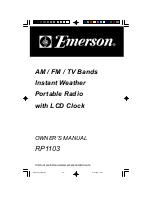
3
W
arning – Batteries
• When inserting batteries, note the correct polarity (+ and -
markings) and insert the batteries accordingly. Failure to do so
could result in the batteries leaking or exploding.
• Only use batteries (or rechargeable batteries) that match the
specified type.
• Before you insert the batteries, clean the battery contacts and
the polar contacts.
• Do not allow children to change batteries without supervision.
• Do not mix old and new batteries or batteries of a different
type or make.
• Remove the batteries from products that are not being used
for an extended period (unless these are being kept ready for
an emergency).
• Do not short-circuit batteries.
• Do not charge batteries.
• Do not throw batteries in a fire.
• Keep batteries out of the reach of children.
• Never open, damage or swallow batteries or allow them to
enter the environment. They can contain toxic, environmentally
harmful heavy metals.
• Immediately remove and dispose of dead batteries from the
product.
• Avoid storing, charging or using batteries in extreme
temperatures.
4. Getting Started
4.1. Inserting the batteries
Measuring station
• Open the battery compartment (24) and remove the contact
breaker. Replace the battery compartment cover.
Base station
• Open the battery compartment (23) and remove the contact
breaker. Replace the battery compartment cover.
4.2. Replacing the batteries
Measuring station
• Open the battery compartment (24), remove and properly
dispose of the dead batteries and insert two new AAA batteries
with the correct polarity. Replace the battery compartment cover.
Base station
• Open the battery compartment (23), remove and properly
dispose of the dead batteries and insert two new AA batteries
with the correct polarity. Replace the battery compartment cover.
N
ote
Before use, ensure you insert the batteries in the measuring
station first and then in the base station.
5. Installation
N
ote – Installation
• We recommend initially placing the base and measuring
stations in the intended locations without installing them and
making all the settings described in
6. Operation
– to do.
• Only install the stations once the appropriate settings have
been made and a stable wireless connection is established.
N
ote
• The wireless transmission range between the measuring and
base stations is up to 30 m in open spaces.
• Before installation, ensure that wireless transmission will not
be disrupted by interference or obstacles like buildings, trees,
vehicles, high-voltage lines, etc.
• Before the final installation, ensure that there is sufficient
reception between the intended installation locations.
• When installing the measuring station, ensure that it is
protected from direct sunlight and rain.
• The international standard height for measuring air
temperature is 1.25 m (4 ft) above ground.
W
arning
• Buy special or suitable installation material from a specialised
dealer for wall-mounting.
• Ensure that no faulty or damaged parts are installed.
• Never apply force during installation. This could damage
the product.
• Before installation, ensure that the chosen wall is suitable for
the weight to be mounted, and make sure that there are no
electrical wires, water, gas or other lines at the installation
site on the wall.
5.1. Base station
• Use the base (22) to position the base station on a level surface.
• Alternatively, you can install the base station on a wall using the
opening (21) on the back.
5.2. Measuring station
• You can also position the measuring station on a level outdoor
surface.
• We recommend installing the measuring station securely on an
outdoor wall using the recess.




































